Abstract
An open clinical trial was conducted in Govt. Ayurveda College Hospital, Thiruvananthapuram, Department of Kayachikitsa and Panchakarma. As there is no work done on the Samyak Snigdha Lakshana (SSL), this study was undertaken to work on the different aspects of Samyak Snigdha Lakshana. To minimize variables, subjects suffering with psoriasis and same Ghritam were selected on the basis of strict inclusion and exclusion criteria. Shodhananga Abhyantara Snehapana was advised before Vamana and Virechana. Samyak Snigdha Lakshanas which are described in all texts are different in milieu. Shodhananga Snehapana with Mahatiktakam Ghritam was given according to Koshta and Agni in 30 subjects. Samyak Snigdha Lakshanas were assessed using a special scoring pattern and the biochemical parameters were observed in all subjects. Statistical analysis using paired′t’ test were done. In all patients Vatanulomana, Diptagni, Snehodvega, Klama and Adhastat Sneha Darshanam were seen; whereas Angalaghava and Twak Snigdhata were noted in less percentage of persons. The onset of various Samyak Snigdha Lakshanas occurs in sequence. There are changes in some biochemical parameters like serum cholesterol, Serum glutamic-oxaloacetic transaminase (SGOT) and fat globules in stool after Snehapana. Shodhananga Snehapana with Mahatikthakam Ghritam decrease features of psoriasis up to some extent. More in depth studies are required to evaluate their importance and for their application in modern medical practice.
Keywords: Mahatikthakam Ghritam, Psoriasis, Shodhanang Snehapana
Introduction
Panchakarma is the main treatment modality which is widely used in all the eight branches of Ayurveda. The Shodhana therapy is more admired by virtue of its capability to completely eliminate the Doshas.[1] On the other hand, it has major disadvantages too. If this therapy is not done with proper indication and Purva-Karma, it may cause hazardous unwanted effects like shock, hemorrhage and death also. To avoid these unwanted effects, Acharyas have instructed to do a proper Purva-Karma.[2] Before adopting Shodhana, it is necessary to do Snehana and Swedana properly. Snehapana is a major preparatory procedure because of its multifaceted action. Shodhananga Abhyantara Snehapana is advised before Vamana and Virechana. Samyak Snigdha Lakshanas which are described in all texts are different in milieu. Some Acharyas have mentioned it in the context of Shodhanartha Snehapana, whereas Acharya like Kashyapa have mentioned it in the context of Shamana Snehapana. So there is no clarification regarding the Samyak Snigdha Lakshana according the type of Snehapana. There are many works available on Snehapana, but there is no work on the Samyak Snigdha Lakshana. Hence this study was planned to work on the different aspects of Samyak Snigdha Lakshana.
Psoriasis is a common chronic scaling skin disorder. The latest survey suggests that as many as two in every hundred of the total population have it at any time in their life. In Ayurvedic classics, Kushtha is the disease where Shodhana is indicated at specific time intervals of which Snehapana is indicated first. Considering the need of study and availability of the patients, psoriasis patients were selected as the condition usually is not associated with major complications.
Aims and objectives
To assess the Samyak Snigdha Lakshana subjectively and objectively with various clinical and biochemical parameters.
To study the effect of the Snehapana with Mahatikthakam Ghritam in Psoriasis.
Materials and Methods
Source of data
Patients of Psoriasis consulting the OPD of Kayachikitsa and Panchakarma Department, Govt. Ayurveda College, Thiruvananthapuram.
Method of collection
30 patients willing to participate in the study were selected based on the clinical features of Psoriasis, considering the inclusion and exclusion criteria. Necessary investigations were carried out and their details were recorded in a special proforma.
Inclusion criteria
Patients with all forms of Psoriasis who are clinically fit to undergo Shodhananga Shodhana procedure.
Age - 15 to 60 years.
Sex - Both sexes.
Exclusion criteria
Clinically unfit for Shodhananga Snehapana.
Chronic debilitating disease.
Malignant Hypertension.
Pregnant ladies.
Patient not willing for admission.
Laboratory investigations
Blood parameters testing and stool examination were done before Snehapana, after Snehapana and after Virechana to assess the changes.
Haemogram- Hb%, TC, DC, ESR.
Blood chemistry- LFT, RFT, BSL, Lipid Profile.
Urine examination- Albumin, Sugar, Deposits.
Stool examination- Fat globules.[3]
Methodology
Assessment of Agni and Kostha was done in every patient on the basis of assessment criteria. Deepana and Pachana were done by administering Panchakolasavam 30 ml twice a day after food and Vaiswanara Choornam 5 gm twice a day before food with warm water for 3 to 5 days till the appearance of the Nirama Lakshanas. In the morning, around 6 a.m. Mahatikthakam Ghritam was given in Arohana Karma from 30 ml to 300 ml to the patient when there was Jeerna Ahara Lakshana and Akshudhita Avastha, with fresh mind, courage and remembering favorite Devata.[4] Ushna Jala boiled with Sunthi approximately 400-500 ml was given as Anupana.[5] Snehapana was stopped after getting Adhastat Sneha Darshanam and Samyak Snigdha Lakshanas were assessed. An interval of three days was given between onset of Samyak Snehana and Virechana Karma. Avipattikar choorna 20-30 gm according to Koshtha of the individual was given with honey around 7 a.m. on the day of Virechana. Samsarjana was advised after Virechana depending upon the type of Shuddhi.
Criteria of assessment
Detailed history, physical and mental examination was done on the basis of a specialized proforma designed for this purpose.
Criteria for assessment of Koshtha
Routine Bowel Habit was considered for assessment of Koshtha as per the following features:
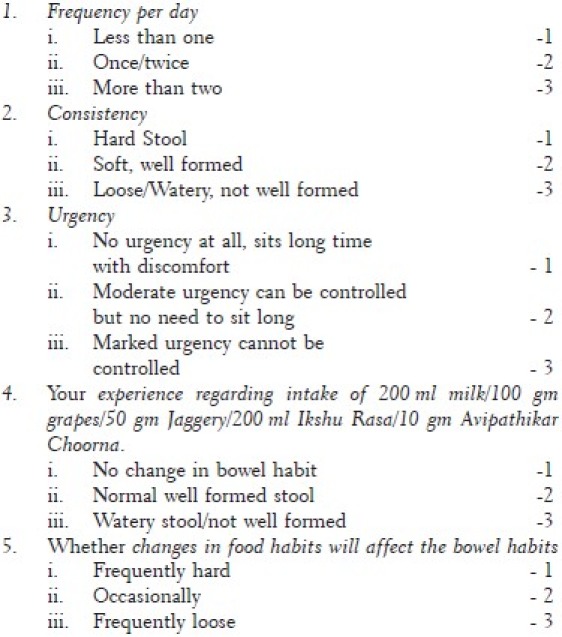
Score
1 to 5 implies - Kroora Koshta
6 to 10 implies - Madhyama Koshta
11 to 15 implies - Mridu Koshta
Assessment of Agni
Effect on hunger, digestion, defecation by occasional, irregular food habits:
No alteration - Tikshn Agni
Mild/Inequitable alteration - Visham Agni
Gross alteration - Mand Agni
Criteria to assess Samyak Snigdha Lakshana
The following subjective criteria were considered for assessment of Samyak Snigdha Lakshana[6]
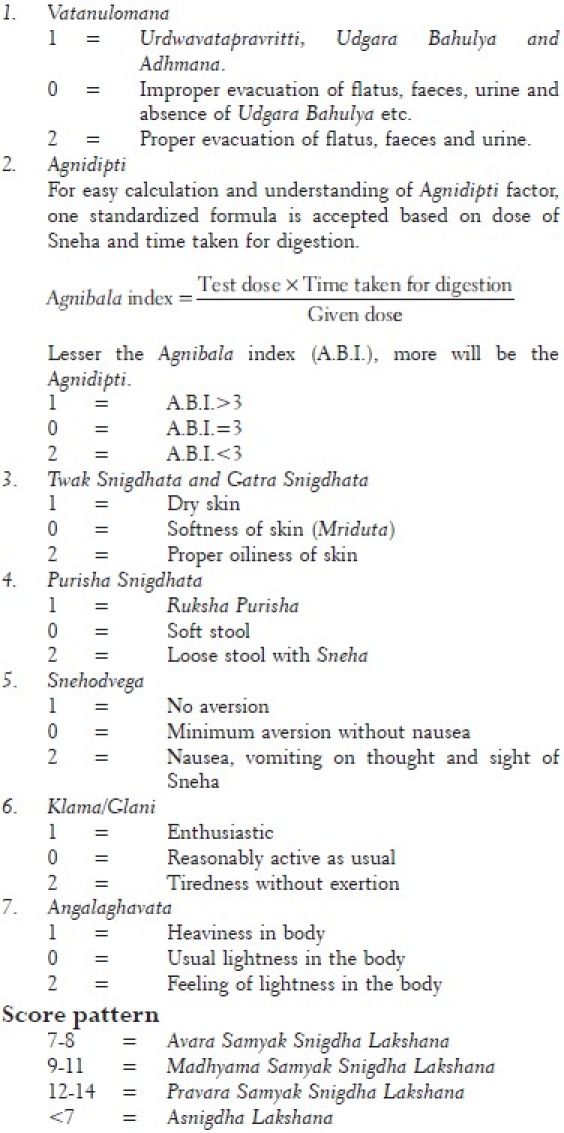
Observation and Results
Maximum patients were from 45 to 60 years age group. Among total patients, 67% of subjects were male and 33% were female. Religion wise distribution showed that maximum number of patients (74%) were from Hindu community. Most of the patients (40%) were having occupations which led to mental stress. Economic status wise distribution of patient shows that 37% patients were belonging to middle class. 53% patients were of Vatakapha Prakriti and 66.6% patients were of Madhyama Sara and 56.6% of Madhyama Samhana. Also, maximum number of patients’ (53.3%), were of Avara Satva category, which may be due to Manasika involvement in Kushta or due to social stigma of skin diseases.
Among all subjects, 49.9% were having Avara Satmya where as 39.9% patients were having Madhyama Satmya. Maximum patients 46.6% were having Madhyama Abhyavaharana Shakti followed by 33.3% and 19.9% of Avara and Pravara Abhyavaharana Shakti respectively. The Jarana Shakti wise distribution shows maximum patients were having Madhyama Jarana Shakti, i.e. 56.7%. In the study, 53.2% patients were having Vishama Agni and 59.9% of patients were having Kroora Koshtha. Among psoriasis features, 100% subjects were having scaling over skin whereas only 26.6% subjects were having itching over skin lesion. 66.6% subjects reported pain as a symptom and 73.2% subjects had erythematic on the lesions. Maximum of 39.9% subjects were administered Ghrita in the dose of 800-1000 ml. Maximum of 49.9% subjects were given 250-300 ml dose on last day. Maximum of 56.6% subjects took 6-7 days for Samyaka Snehana. 36.6% subjects required 4-5 days for getting Samyak Snigdha Lakshana.
Observations on Samyak Snigdha Lakshana
In the Arohana Snehapana group, after administration of Sneha, the symptoms of Sneha Jiryamana were observed. The mean onset time and duration of those symptoms were noted in minute [Table 1].
Table 1.
Observation on Jeeryamana Lakshana during the study
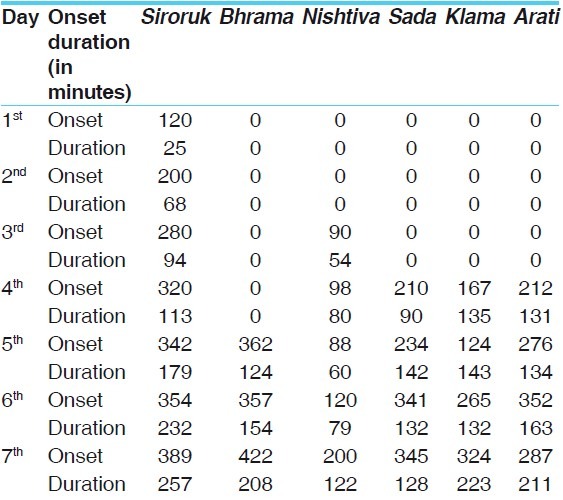
All the Sneha Jiryamana Lakshana reported by the subjects automatically subsided on Sneha Jeerna.
Observation related with mean score of Samyak Snigdha Lakshana with S.D. and percentage was on last day of Snehapana all subjects showed Vatanulomana, Diptagni, Purisha Snigdhata and Snehodvega with mean score of 1.9, 1.9, 2.0 and 1.8 respectively. Whereas 93.3% subjects showed Klama Lakshana with S.D. 0.4, 86.5% subjects noticed Twak Snigdhata with mean score of 1.4 (S.D.±0.8) and only 13.3% subjects perceived Angalaghavata with mean score of 0.6 (S.D.±0.2) [Table 2].
Table 2.
Samyak Snigdha Lakshana observed in 30 patients during the study
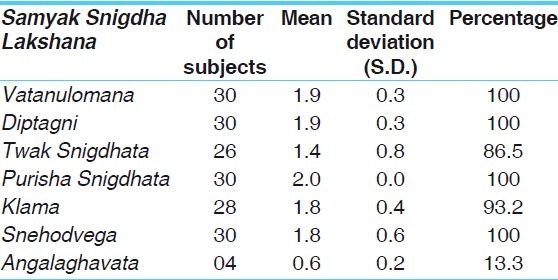
The pattern of Samyak Snigdha Lakshana found in 30 subjects with respect to Snehapana days. Vatanulomana was seen in 80% of subjects on 1st day, 87.7, 96.4, 97.6, 98.5, 89.6 and 100% of subjects showed on subsequent days. Diptagni was seen in 100% subjects on 1st day followed by 97.5% of subjects on 2nd day, 93.4% on 3rd day, 96.5% on 4th day, 95.9% on 5th day, 98.3% on 6th day and 100% subjects on 7th day [Table 3].
Table 3.
Pattern of Samyak Snigdha Lakshana found in 30 subjects during the study
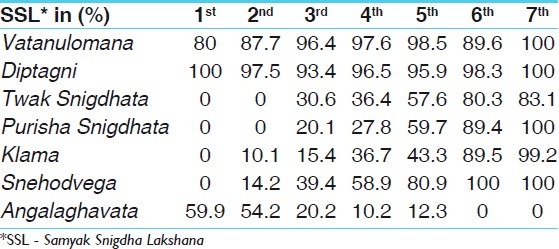
Maximum number subjects (60%) noted Pravara Snigdhata grade while 30% subjects reported Madhyama Snehana grade and only 10% subjects put in the picture were of Avara Snehana grade [Table 4].
Table 4.
Distribution of Snigdhata grade achieved after Snehana Karma during the study

The details of Samyak Snigdha Lakshana during the gap days shows - on the 1st and 2nd gap day, Vatanulomana was experienced by all subjects while on 3rd day only 96.5% of subjects recounted it. Diptagni was described by all subjects on 1st Vishrama Dina whereas 93.2% subjects reported it on 2nd day and 83.5% stated it on 3rd gap day [Table 5].
Table 5.
Assessment of Samyak Snigdha Lakshana during gap days of the study
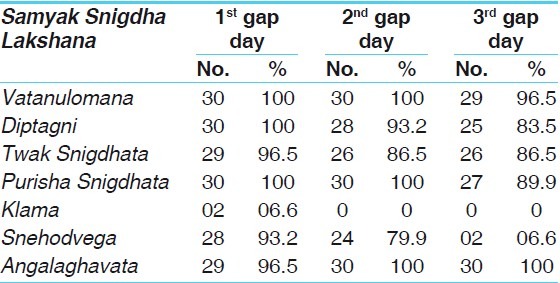
The role of Snehana according to Prakriti reveals that maximum subjects, i.e. 11, who took 6-7 days to get Samyak Snehana were of Vata-Kaphaja Prakriti and the same no. of subjects attained Pravara Snigdhata grade. Among Pitta-Kaphaja Prakriti subjects, five subjects necessitated 4-5 days for Snehana therapy and two subjects required 6-7 days and only one patient required 1-3 days for Snehana therapy. Among them, five subjects got Pravara Snigdhata grade and two subjects reported Madhyama Snigdhata grade.
In case of Vata-Pittaja Prakriti, maximum four subjects required 6-7 days for Samyak Snehana therapy, 1 patient got Samyak Snehana in 1-3 days and the same no. in 4-5 days. Among them four subjects attained Madhyama Snehana grade and two subjects reported Pravara Snigdhata grade [Table 6].
Table 6.
Role of Prakriti in Snehana during the study

In this study, seven subjects of Vishamagni amongst sixteen took 4-5 days for Samyak Snehana and nine subjects required 6-7 days for getting Samyak Snigdha Lakshana. Out of them, eight subjects got Pravara Snigdhata grade, six subjects got Madhyama Snigdhata grade and only two subjects got Avara Snigdhata grade. Among Mandagni subjects, six subjects attained Samyak Snehana in 6-7 days and three subjects took 4-5 days. Amongst them, six subjects attained Pravara Samyak Snehana grade, two subjects reported Madhyama Snigdhata grade and only one patient showed Avara Snigdhata grade.
Among five subjects having Tikshnagni, two subjects achieved Samyak Snehana in 6-7 days and one subject took 4-5 days. Amongst them four subjects attained Pravara Samyak Snehana grade, one subject reported Madhyama Snigdhata grade [Table 7].
Table 7.
Role of Agni in Snehana during the study

In this study sixteen subjects having Kroora Koshta among eighteen, took 6-7 days for Samyak Snehana and two subjects required 4-5 days for getting Samyak Snigdha Lakshana. Out of whom eight subjects got Pravara Snigdhata grade, eight subjects got Madhyama Snigdhata grade and only two subjects got Avara Snigdhata grade.
Among Madhyama Koshta subjects, only one subject attained Samyak Snehana in 6-7 days and the rest seven subjects took 4-5 days. Amongst them seven subjects achieved Pravara Samyak Snehana grade and only one patient showed Avara Snigdhata grade. Among Mridu Koshta subjects, two subjects attained Samyak Snehana in 1-3 days and two subjects took 4-5 days. Out of them three subjects attained Pravara Samyak Snehana grade, one subject reported Avara Snigdhata grade [Table 8].
Table 8.
Role of Koshta in Snehana during the study

Effect of therapy
Effect of Snehapana on blood parameters
Effect of Snehapana on erythrocyte sedimentation rate was found decreased with statistically insignificant results [Table 9]. Serum cholesterol level was decreased significantly (P <0.01) in SSL and AS in comparison to BS [Table 10]. SGOT and SGPT levels were decreased in SSL and AS in comparison to BS which was statistically significant (P <0.01) [Tables 11, 12]. But the changes found in all the blood parameters were within physiological limits.
Table 9.
Effect of Snehapana on erythrocyte sedimentation rate during the study

Table 10.
Effect of Snehapana on serum cholesterol during the study

Table 11.
Effect of Snehapana on serum glutamicoxaloacetic transaminase during the study

Table 12.
Effect of Snehapana on serum glutamic pyruvic transaminase during the study

Effect of Snehapana on stool parameter
The result of Snepana was assessed on stool fat globules which was found statistically highly significant (P<0.01) in BS, SSL and AS as compared to each other [Table 13].
Table 13.
Effect of Snehapana on stool fat globules during the study

Effect of Snehapana on psoriasis features
Effect of Snepana was assessed on cardinal features of Psoriasis i.e. on Scaling shows statistically highly significant results (P<0.01) [Table 14]. Maximum number of subjects who showed Pravara grade of Snehana, also reported Pravara Shodhana and vice versa [Table 15]. No significant increase or decrease in vital data like pulse, respiratory rate and blood pressure were found before and after Snehapana.
Table 14.
Effect of Snehapana on scaling during the study

Table 15.
Role of Snehana in Virechana
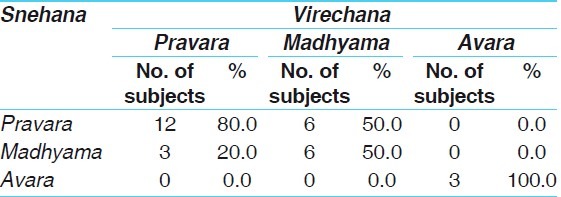
Discussion
Shodhanartha Abhyantara Snehapana is the foundation for purification procedures. There are mainly two effects of the Shodhananga Snehapana;
To prepare the body by bringing the Doshas from Sakhas to the Koshtha from where they can be easily expelled out.[7]
To get the proper Shodhana effect and prevent further complications of Shodhana procedures.
The therapeutic action attributed to Shodhananga Snehapana by Caraka as is ‘Snehanam Sneha Vishyandam Mardava Kledakarakam’. It can be considered as the tool for producing SSL that means Snehana produces Twak Snigdhata, Vishyandana causes Adhastat Sneha Darshanam, Mardavata of Snehana leads to Gatra Mardavata and Kledana is responsible for Asamhata Varchas. So we can say that in Shamana and Brimhana Snehapana, Snehana and Mardava effects can be seen whereas Kledana and Visyandana effects will not be seen, as the last two effects excite the Dosha and so are not intended in Shamana and Brimhana Snehapana. Among SSL, Vatanulomana, Diptagni were present from 1st day of Snehapana which may be because of Snigdha Guna of Sneha. Due to intake of Sneha Anulomana of Apana Vayu occurred, which resulted in the good functioning of Apana Vayu and Pachaka Pitta and in turn Agnidipti was observed. Purisha Snigdhata was started to be observed from 3rd day onwards. It suggests the gradual Snigdhata of Purishavaha Srotas, which will reach maximum by 7th day. Twak Snigdhata suggests that Sneha has reached up to Rasa, Rakta, Mamsa and also Majja Dhatu as explained by Vagbhata, “Sneho Akshi Twagvisham…”
Caraka explains this with illustration that just as water saturates the cloth to its capacity then drains off, similarly the unctuous dose gets digested according to the strength of Agni and drains off when it exceeds the limit of Agni. Cakrapani comments that it is direction to find when to stop Snehapana.[8] The data suggest that all the symptoms of Samyak Snehana do not appear on the same day but as Snehana process goes on, the Lakshana appear one by one. At first Mahastrotas becomes Snigdha. So, Agnidipti and Vatanulomana are observed in initial days. Further when Asamhata Varchas appears the complete Snehana of Annavaha and Purishavaha Srotas can be understood. Afterwards Twak Snigdhata appears. This reveals that Snigdhata has reached up to Dhatu level. At last Snehodvega and Adhastat Sneha Darshanam were noted suggesting that there is no need of further Snehana. So from the above data it can be understood that the onset of Snehana Lakshana described by Caraka and other Acharyas are in the sequence of appearance. However the symptom like Twak Snigdhata is little difficult to achieve or may not appear in all the patients.
Probable mode of action of Snehana
Shodhananga Abhyantara Snehapana is the basis to make a smooth platform for Shodhana, i.e. to attain the Utkleshavastha of Dosha.
The importance of Snehana as Purva Karma for Shodhana is well known.
The features produced after Snehana suggest that there is loosening of morbid Doshas which were adherent to the walls of transforming channels and which in turn will help in the Shodhana Karma, performed afterwards. When Snehana was done by increasing dose schedule where increase of dose per day was decided according to Agni, Koshta, Bala Avastha, etc. the Snehana occured in its full fledged form.
Snehodvega suggests the Sanchayavastha by “Chayakarane Vidvesha” as per Sushruta. The symptoms of Rasa Vridhi like Hrillasa, Praseka signifies the increase of Apyamsha in the body which is the action of Snehana i.e., Vriddhi for bringing the Doshas from Sakha into the Koshtha from where they can be easily expelled out. Adhastat Sneha Darshanam suggests that there is no need for further Snehana.
After proper Snehapana three days gap has been given before Virechana to get Agni in its normal form so that it can digest Virechana medicine as ‘Pachyamane Virechanam’ is told by Acharya.
Effect of Virechana Karma was also dependent upon Snehana process.
Mahatikthakam Ghritam was used for Snehana and so it has provided Shamana effect on Psoriasis features.
Conclusion
Snehapana should be done with well planned method. Consideration of Agni and Koshtha must be done for deciding the dose and duration of Snehapana. Onset of various SSL occurs in sequence which may be helpful in predicting the duration of Snehapana. There are no significant changes in the blood parameters due to Snehapana. The significant changes in stool with respect to presence of fat globules were seen. Shodhananga Snehapana with Mahatikthakam Ghritam in Psoriasis decreases the clinical features to some extent.[9] If Virechana is performed after proper Snehana, better and safer Suddhi can be achieved.
Acknowledgment
For this study I am very thankful to all my seniors, juniors, classmates and my patients who tried to understand while I communicated in Malayalam and taught me a better language for communication.
References
- 1.Acarya Vaidya Yadavji Trikamji., editor. Caraka-Caraka Samhita, commentary by Cakrapani. Varanasi: Chowkhamba Krishnadas Academy, Oriental publishers; 1994. [Google Scholar]
- 2.Paradkar Harishastri., editor. Vagbhata - Ashtanga Hridaya, commentary by Arunadatta and Hemadri. Varanasi: Chowkhamba Krishnadas Academy; 1995. [Google Scholar]
- 3.Godkar Praful B., Godkar Darshan P. Text book of Medical Laboratory technology. 2nd ed. Mumbai: Bhalani Publishing house; 2003. [Google Scholar]
- 4.Sharma P.V., translator. Sushruta - Sushruta Samhita, English translation. Varanasi: Chaukambha Vishwabharati; 1999. [Google Scholar]
- 5.Murthy K.R. Srikanta., Prof., translator. Vagbhaa - Ashtanga Sangraha, English translation. Varanasi: Chaukambha Orientalia; 2000. [Google Scholar]
- 6.Ramteke Rajkala., MD . Ayu. thesis, An open clinical trial to analyze Samyak Snigdha Lakshana of Shodhanang Snehapana with Mahatikthakam Ghritam in psoriasis. Thiruvananthpuram: Methodology, Govt. Ayurveda College; 2009. [DOI] [PMC free article] [PubMed] [Google Scholar]
- 7.Sushruta - Sushruta Samhita, commentary by Dalhana and Gayadasa. Varanasi: Chaukambha Orientalia; 1992. [Google Scholar]
- 8.Caraka-Caraka Samhita, commentary by Cakrapani and Gangadhara Kaviratna Kaviraja. 96. Vol. 13. Varanasi: Chaukambha Orientalia; 1991. [Google Scholar]
- 9.Indira Balachandran. Indian Medicinal Plants, V.P.S.V. Aryavaidyasala Kottakal. Chennai: Orient Longman Publication; 1994. [Google Scholar]


